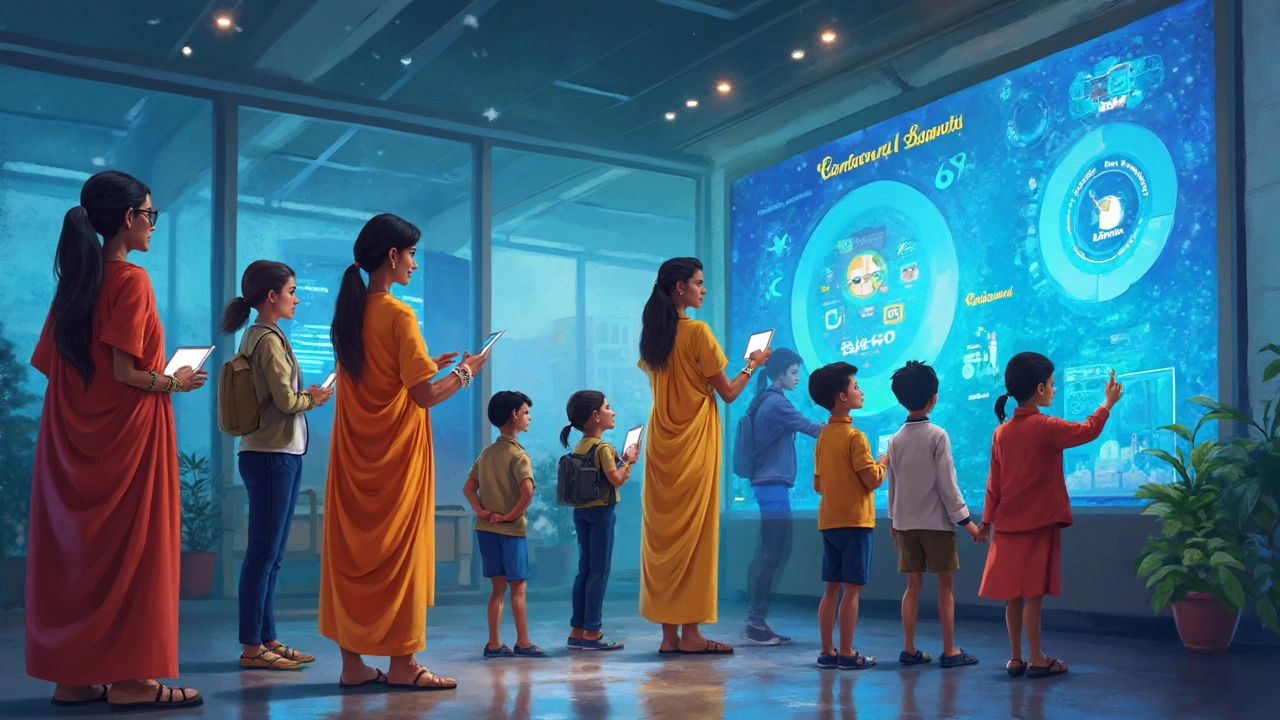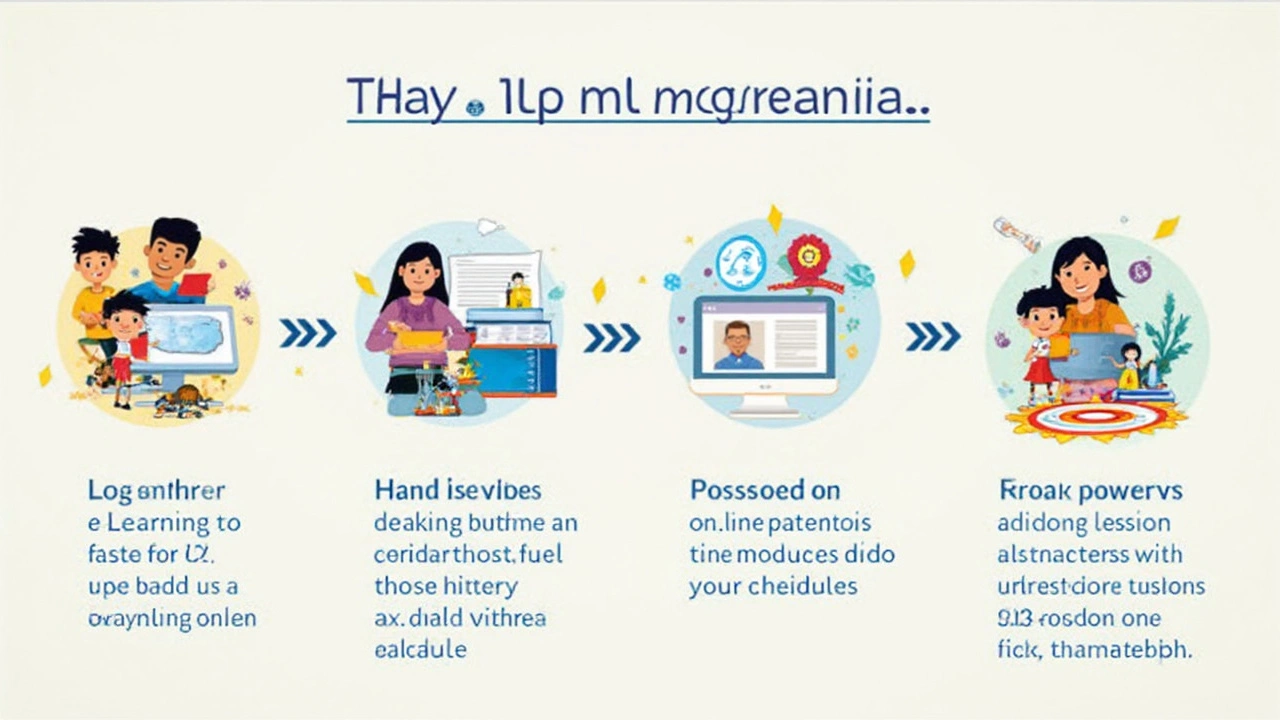Imagine swapping a crowded classroom for your own couch and tapping into a lesson with just a few clicks. That’s the magic of eLearning. It’s not just about putting textbooks online—today’s platforms mix videos, quizzes, group talks, and even live sessions to keep things interesting.
Everything runs on a digital platform. You sign up (sometimes for free), get a login, and suddenly have access to courses on anything from coding to public speaking—right from your browser or an app. Instead of a chalkboard, your screen becomes the main tool. Lessons might roll out as videos, slides, or interactive games, and you can usually rewind tricky parts as many times as you want.
For parents with kids like my Rishi, eLearning means you can spot what your child is doing thanks to real-time progress dashboards. And for anyone juggling work, kids, or just a nutty schedule, these platforms let you learn at your own speed—no strict bell schedule, no commute. Think of it as education on your own terms.
- What Is eLearning, Exactly?
- How eLearning Platforms Deliver Content
- Interactive Tools and Features You’ll Use
- Tracking Progress and Getting Feedback
- Tips for Making eLearning Work for You
What Is eLearning, Exactly?
eLearning is basically any kind of learning you do through digital devices instead of sitting in a traditional classroom. The most common way is through online learning platforms that host lessons, videos, assignments, and ways to chat with teachers and other students. You can log in anytime and start a course, no matter where you are—coffee shop, sofa, or even in the car waiting to pick up your kid.
This kind of learning really took off when schools and workplaces closed during COVID-19. To give you some perspective, a 2023 report showed that almost 70% of U.S. college students took at least one class online. It’s not just for schools, either—companies use eLearning to train staff, and even government offices rely on it for ongoing workshops.
There are a few main types of eLearning:
- Self-paced courses: You move at your own speed. Watch lessons, take quizzes, and only move on when you’re ready.
- Live virtual classrooms: You and your classmates join live video calls with a real instructor teaching in real time.
- Hybrid learning: Mixes online tasks with in-person activities. This is big in schools trying to give students more flexibility.
Most eLearning platforms offer extra features—not just reading and watching, but also interactive quizzes, discussion groups, and instant feedback. And since everything is recorded or tracked online, you can see exactly how you or your kid is doing at any time.
| Type of Learning | Where It Happens | Main Tools |
|---|---|---|
| Traditional | Physical classroom | Textbooks, chalkboards |
| eLearning | Anywhere (home, café, bus) | Videos, apps, quizzes |
With digital education now everywhere, it’s easy to find courses in art, math, IT, and even cooking. There’s something for every interest and learning style—just pick a platform and get started.
How eLearning Platforms Deliver Content
Here’s where the tech does the heavy lifting. eLearning platforms are basically the digital classrooms you log into. Each one has its own way of serving up lessons, but most use a stack of different tools so you’re not just reading slides until your eyes glaze over.
Most online learning platforms do these things:
- Recorded lectures and short videos: These make up the core of tons of courses—think YouTube, but more organized. Learners can pause, rewind, or speed up based on what clicks.
- Readings and downloads: Stuff like PDFs and worksheets make it easy to save copies of key info, highlight points, or print cheat sheets.
- Live sessions: Many platforms now offer live Zoom-style classes so you can interact, ask questions, or just feel like you’re in an actual class with others. The live chat and Q&A tools make it less lonely.
- Mobile learning: Almost all big e-learning platforms have an app, so you can finish a lesson while waiting for soccer practice to finish. This matters if you want true flexibility.
Behind the scenes, there’s usually a learning management system (LMS). That sounds fancy, but it’s really just the engine making sure lessons, quizzes, and assignments reach you. The LMS keeps track of your spot in the course, shows deadlines, and pushes reminders—so there’s less chance you lose momentum. Schools and companies might use popular LMSs like Moodle, Blackboard, or Canvas. Big names like Coursera and Udemy run their own custom platforms built for scale.
| Platform | Content Types | Delivery Options |
|---|---|---|
| Coursera | Video lectures, quizzes, peer-reviewed tasks | Self-paced & instructor-led |
| Khan Academy | Videos, exercises, progress dashboard | Completely self-paced |
| Udemy | Videos, articles, Q&A, downloadable resources | Self-paced |
| Google Classroom | Assignments, feedback, slides, live links | School-based, hybrid |
So, whether you like to learn step by step or in big sprints, eLearning platforms are built to fit all styles. And if you get stuck, there’s often a search bar or forum so you can get answers fast—almost like raising your hand in class, minus the nerves.

Interactive Tools and Features You’ll Use
Think eLearning is just videos and slides? It’s way more hands-on these days. Most eLearning platforms have features built to keep you active, not just staring at a screen. Here’s what really keeps folks engaged:
- Live Classes and Video Calls: Just like a regular classroom but on Zoom, Google Meet, or built-in video tools. You can ask questions, join discussions, and work in breakout groups.
- Quizzes and Instant Feedback: After a lesson, quizzes pop up so you can check your understanding. Platforms give feedback in real time—no need to wait for someone to grade your work.
- Interactive Whiteboards: Teachers (and sometimes students) can draw, write, or upload images, making things less boring than just text. This helps everyone visualize tricky stuff.
- Discussion Boards: You can leave questions, answer classmates, or debate topics. It’s a good way to get help or see a problem from a new angle.
- Simulations and Games: Some online learning sites use science labs, language games, or coding sandboxes to let you practice skills by doing, not memorizing.
- File Sharing and Cloud Storage: Upload homework, download handouts, or share project files without a zillion emails.
One big perk is that many learning platforms use notifications—little nudges so you don’t fall behind. If your kid’s school uses Google Classroom, you’ll know exactly what’s due because the system pings you.
It’s not just for individual work. Collaborative docs let students work together on essays or presentations, even if they’re sitting miles apart. And if you get stuck, chat windows and help bots are right there—sometimes they can answer basic questions faster than a real teacher.
| Tool/Feature | What It’s For |
|---|---|
| Quizzes | Check understanding, spot weak spots fast |
| Discussion Boards | Peer support, brainstorming, Q&A |
| Live Video Sessions | Direct teaching, group interaction |
| Interactive Whiteboards | Visual explanations, drawing out ideas |
| Game-Based Learning | Practice skills, increase motivation |
Not every platform offers all these bells and whistles, but the best ones pack in enough tools so both kids and adults stay motivated. If you’re not sure where to start, look for a site that at least has live help, quizzes, and a way to talk to other learners. These three can make all the difference when the going gets tricky.
Tracking Progress and Getting Feedback
One of the coolest things about eLearning is how easy it is to track your progress. Forget guessing how you’re doing—most online learning platforms show your scores, completed lessons, and streaks front and center. A dashboard usually sums it all up. If you’re taking a coding course, for example, you’ll see how many modules you’ve nailed or which quizzes tripped you up.
Let’s talk about feedback. After quizzes or assignments, the system often gives instant results. Sometimes you even get detailed breakdowns showing what you missed and why. For trickier stuff, like essays or projects, real teachers or course mentors can leave comments you can read right in the system. This is so much faster than waiting for a paper to come back with red ink all over it.
A lot of platforms use automated grading for multiple-choice assignments. But for bigger tasks, you’ll usually see comments within a couple days. This combo helps you fix mistakes as you go, not weeks later.
Here’s a quick snapshot of what you might find on a digital dashboard:
- Lesson completion bars (so you know how much is left)
- Quiz scores and averages
- Badges or certificates for finishing sections
- To-do lists with reminders for unfinished work
Here’s a fun fact: according to a 2023 Coursera report, learners who checked their dashboard at least once a week were twice as likely to finish their courses compared to those who didn’t.
| Feature | Benefit |
|---|---|
| Instant Quiz Results | Shows strengths and weaknesses right away |
| Progress Bars | Keeps you motivated |
| Peer or Teacher Comments | Tips for improvement |
| Automated Reminders | Helps you stay on track |
If you’re a parent like me, you can usually peek at your kid’s analytics to see attendance, scores, or even average time spent per lesson. This makes it easier to know if it’s time for a pep talk or maybe a high five.
"Our research shows that immediate feedback in digital education promotes faster learning and more engagement." — Dr. Priya Venkatesh, EdTech Researcher
To get the most out of feedback, don’t skip the reviews or gloss over comments. That’s where the important learning happens. If your goal is to genuinely master a new skill, keep checking your dashboard and actually read the tips—those two habits alone can change your results.

Tips for Making eLearning Work for You
Making the most out of eLearning doesn’t have to be a guessing game. With screens tempting you to check messages or get sidetracked, staying on track is a real thing to watch out for. Here’s how you can keep up and actually learn stuff you’ll remember.
- Set up a clear study space: Nothing fancy, but get a spot where you won’t be distracted. Even just a corner of the kitchen table can help your brain switch to "study mode."
- Stick to a routine: Logging in around the same time, say after breakfast or right before dinner, trains your brain and keeps you from falling behind. Some folks use a calendar app to block out “learning time.”
- Break content into chunks: Rather than binging a whole course, take it one video or lesson at a time. The Pomodoro method (25 minutes work, 5 minutes break) is honestly a lifesaver for focus.
- Ask questions and join the forums: Most online learning platforms include chat rooms, Q&A boxes, or discussion boards. Speaking up or just reading others’ questions can clear up what doesn’t make sense right away.
- Test yourself: Don’t just watch and move on—try every quiz, worksheet, or flashcard. Research from 2023 showed that students who took low-stakes quizzes online scored 17% better in final assessments compared to those who skipped them.
- Review progress often: Platforms often track completions, scores, and streaks. Use these as mini-goals. Checking your dashboard or progress bar gives that little hit of achievement that actually helps motivation.
If you’re learning with kids, break lessons around their attention span. For example, if Rishi can only focus for 15 minutes, that’s totally normal. Most digital education platforms know this and design materials to fit shorter bursts.
Stuck or feeling lost? Don’t wait—most learning platforms offer quick help via live chat or support tickets. It’s faster than hunting solutions on your own.
| Tip | What Works |
|---|---|
| Staying Motivated | Set tiny goals and celebrate wins—like finishing a module or passing a quiz. |
| Blocking Distractions | Turn off notifications; use browser extensions like StayFocusd. |
| Asking for Help | Reach out to mentors, tutors, or course forums if you’re stuck more than 15 minutes. |
One last tip—try not to multitask. Even if you think you can, studies say it slows learning by up to 40%. Give your lesson your full attention, and you’ll get through faster with better results.
